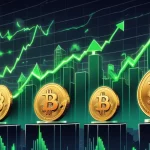XRP Price Surges 5% After Ripple Drops SEC Appeal: Is $10 Realistic?

XRP Price Prediction: Can It Hit $10 After Ripple’s SEC Lawsuit Move?
Ripple’s latest strategic play in its ongoing battle with the U.S. Securities and Exchange Commission (SEC) has sent ripples through the crypto market, with XRP’s price spiking over 5% and reigniting debates about its future value. As speculation swirls around a potential $10 price target, we’re cutting through the noise to unpack the legal, financial, and technological developments driving this altcoin’s trajectory—along with the hefty dose of skepticism they deserve.
- Legal Shift: Ripple CEO Brad Garlinghouse drops cross-appeal in SEC lawsuit, signaling confidence and boosting XRP’s price by 5%.
- ETF Buzz: High hopes for a U.S.-based XRP ETF, with BlackRock rumors and strong approval odds, though hurdles remain.
- Tech Edge: Wormhole integration enhances XRP Ledger’s cross-chain interoperability, a critical step for real-world adoption.
Legal Breakthrough: Dropping the Cross-Appeal
The headline-grabbing news comes straight from Ripple’s corner, where CEO Brad Garlinghouse has made a bold call to withdraw the company’s cross-appeal in a nearly four-year legal clash with the SEC. For those new to this saga, the dispute began in 2020 when the SEC accused Ripple of selling XRP as an unregistered security—think of it as offering a stock or bond without the proper paperwork, a claim Ripple fiercely contests by arguing XRP is simply a digital currency. A partial victory came in 2023 under Judge Analisa Torres, who ruled that XRP sales on public exchanges didn’t violate securities laws, though institutional sales worth $728 million did, resulting in a $125 million fine—far below the SEC’s initial $2 billion demand. Garlinghouse’s latest move to drop the cross-appeal isn’t a surrender but a confident bet on Ripple’s business model, as he declared:
“We’re closing this chapter once and for all.”
This decision sparked an immediate 5% surge in XRP’s price, a welcome jolt after a brutal 35% drop from its first-quarter peak, trapped in a downward trend. Retail and institutional investors alike seem to interpret this as a signal that regulatory clarity—long a dark cloud over XRP—might finally be within reach, and community reactions on platforms like Reddit reflect mixed sentiments on this price surge following the SEC move. But don’t get too cozy with that optimism. A recent court rejection of a settlement to lower the fine or lift an injunction shows the SEC isn’t rolling over easily. While Ripple’s move hints at a potential endgame, the legal battlefield is still littered with landmines, and betting big on a swift resolution is a gamble. This isn’t just Ripple’s fight; a favorable outcome could set a precedent for dozens of altcoins under SEC scrutiny, potentially reshaping how the U.S. handles digital assets. Yet, with ongoing uncertainty, XRP holders need to brace for more turbulence before any victory lap. For a deeper dive into the background of this legal battle, check out the comprehensive overview on Ripple Labs’ legal history.
XRP ETF Speculation: Hype or Reality?
A major driver of XRP’s renewed buzz is the growing chatter around a U.S.-based XRP Exchange-Traded Fund (ETF). For the unversed, ETFs are investment products traded on stock exchanges that track an asset’s price—in this case, XRP—allowing traditional investors to dip into crypto without owning it directly. They’re a critical bridge between Wall Street and blockchain, and Ripple’s legal pivot has supercharged speculation about an imminent approval. Nate Geraci, president of The ETF Store, captured the sentiment perfectly:
“Ripple’s recent decision [to drop the cross-appeal] is a turning point. Now, the odds are more than ever for XRP ETF to be approved.”
Bloomberg analysts are throwing around a staggering 95% chance of approval, while Polymarket bettors peg a 78% likelihood by the end of 2025. Rumors point to BlackRock, the asset management giant behind successful Bitcoin and Ethereum ETFs, as a potential frontrunner to launch an XRP fund. Their involvement would be a game-changer, given the U.S. market’s sheer size—trillions in institutional capital dwarf Canada’s scope—potentially driving massive inflows, as discussed in recent news on BlackRock’s potential XRP ETF plans. Look at Canada’s 3iQ XRP ETF, which has already amassed $32 million in assets under management, as proof of demand. If BlackRock steps in, some analysts estimate XRP could see price jumps akin to Bitcoin’s post-ETF rally, with further insights available in this analysis of BlackRock-XRP ETF rumors.
But hold your horses. BlackRock hasn’t confirmed a damn thing, and they’ve previously shied away from altcoins like XRP due to regulatory quicksand. The SEC’s foot-dragging on other XRP ETF filings from firms like Grayscale and 21Shares doesn’t exactly scream “fast track.” Unlike Canada, where progressive rules have welcomed crypto funds, the U.S. remains a bureaucratic maze. Remember the years-long drama over Bitcoin ETFs? XRP could face a similar slog. While the hype is palpable, the reality of regulatory lag and BlackRock’s silence means this ETF dream might stay just that—a dream—for longer than the bulls are banking on. Curious about the potential impact of an ETF on XRP’s price? Discussions on platforms like Quora explore the likelihood of XRP ETF approval and its market effects. As advocates of decentralization, we’re eager to see XRP challenge traditional finance, but we’re not holding our breath for Wall Street to play nice anytime soon.
Tech Wins: Wormhole and Cross-Chain Interoperability
Beyond legal and financial headlines, XRP’s quieter but equally vital story lies in its technological strides. Ripple CTO David Schwartz has been pounding the table on the need for cross-chain interoperability—the ability for different blockchains to communicate and transfer assets seamlessly. Think of it as a universal translator, ensuring money or data on the XRP Ledger (XRPL) can move to Ethereum, Solana, or over 35 other networks without getting lost in translation. Schwartz put it bluntly:
“If you want real mass adoption, interoperability is essential. The infrastructure has to be there, not just on one chain, but across them.”
The recent integration of Wormhole, a protocol bridging multiple blockchains, into XRPL is a concrete step forward. This isn’t just tech jargon; it’s a foundation for practical use cases, as detailed in this report on Wormhole’s integration with Ripple. From tokenized real-world assets—Dubai’s real estate platform runs on XRPL—to Ripple’s stablecoin RLUSD, boasting a $400 million supply across XRP and Ethereum chains, interoperability positions XRP as a serious player in decentralized finance (DeFi). Compared to Ethereum’s complex bridge systems or Polkadot’s relay chain model, XRPL’s focus on speed and low-cost transactions via Wormhole gives it a unique edge for institutional adoption, especially in cross-border payments—a niche Bitcoin, with its unmatched security and decentralization, doesn’t directly target. Further analysis on this development can be found in discussions about XRP’s cross-chain potential with Wormhole.
This tech push aligns with the industry’s broader shift toward blockchain agnosticism, where no single chain rules and networks play nice. It’s not flashy like a price pump, but it’s the kind of boring, foundational work that could make XRP a backbone of global finance. For those of us championing effective accelerationism, this is the stuff that matters—disrupting sluggish systems with real, scalable solutions. Still, adoption isn’t guaranteed; XRP must compete with heavyweights like Ethereum and Avalanche in the interoperability race, and tech alone won’t overcome regulatory or market headwinds.
Price Predictions: Separating Fact from Fiction
No XRP discussion would be complete without the inevitable price crystal ball. Analyst “Captain Redbeard” has tossed out a $10 target, hinging on legal clarity, bullish market sentiment, and XRP breaking out of its current consolidation near strong support levels—basically, where buyers might step in to halt further drops. It’s a tantalizing figure, especially since XRP’s all-time high sits at $3.40 from the 2018 bull run, and some are speculating on whether XRP can reach $10. Others, like analysts cited by AInvest, offer a more grounded post-ETF approval estimate of $4.60, drawing parallels to Bitcoin and Ethereum’s ETF-driven rallies. But let’s slap some cold water on this hype train. A $10 price implies a market cap nearing $1 trillion—more than Bitcoin’s current valuation—a pipe dream in today’s climate, even with institutional money flooding in.
As much as we root for decentralization to stick it to centralized finance, these double-digit predictions reek of the same tired crypto shilling we’ve debunked countless times. XRP’s 35% tumble this year is a harsh reminder that gravity exists, and the market is littered with broken “moonshot” promises. Historical volatility—XRP has swung wildly between pennies and dollars—underscores the risk. Sure, legal wins and ETF approvals could spark a rally, but structural issues like regulatory overhang and altcoin competition loom large. If wishes were Satoshis, we’d all be trillionaires—let’s stick to the hard data. A spike to $4 or $5? Maybe, under perfect conditions. $10? That’s a long shot, and peddling it as likely is borderline irresponsible. Our audience deserves better than empty hype.
Ripple’s Fight: A Blueprint for Crypto Regulation?
Zooming out, Ripple’s legal tussle carries weight far beyond XRP’s price chart. A clear regulatory framework for XRP could ripple outward—pun intended—easing SEC pressure on altcoins like Cardano, Stellar, or even smaller tokens facing similar “unregistered securities” claims. The U.S. risks falling behind as global hubs like Canada, with its thriving XRP ETF, and Dubai, leveraging XRPL for real estate, build the future of finance. If Ripple secures a win or a workable compromise, it might force American policymakers to rethink their heavy-handed approach, accelerating crypto’s integration into mainstream systems—a cause we’re all in for. For the latest on this legal front, refer to updates on Ripple’s decision to drop the cross-appeal against the SEC.
Yet, the SEC’s stubbornness, evidenced by the rejected settlement, suggests this won’t be a clean sweep. Other projects under fire might not have Ripple’s resources to fight back, leaving them vulnerable even if XRP emerges unscathed. This saga is a microcosm of crypto’s broader struggle for legitimacy—can innovation outpace regulation, or will bureaucracy choke the life out of decentralization? It’s a question worth pondering as we watch Ripple navigate this high-stakes chess game.
Key Takeaways and Questions for XRP’s Future
- What triggered the 5% surge in XRP’s price?
Ripple CEO Brad Garlinghouse’s decision to drop the cross-appeal in the SEC lawsuit ignited investor confidence, signaling potential regulatory clarity and driving the uptick. - Is a U.S.-based XRP ETF approval on the horizon?
Bloomberg analysts estimate a 95% chance, with Polymarket users at 78% by 2025, but SEC delays and BlackRock’s lack of confirmation keep uncertainty high. - Why does BlackRock’s rumored role in an XRP ETF matter?
As a leader in asset management with Bitcoin and Ethereum ETF successes, BlackRock’s potential involvement could draw massive institutional capital to XRP, though nothing is confirmed. - How does cross-chain interoperability boost XRP’s potential?
The Wormhole integration connects XRPL to over 35 networks, enabling seamless asset transfers—a must for mass adoption, as Ripple CTO David Schwartz emphasizes. - Is a $10 price target for XRP feasible?
Analyst “Captain Redbeard” suggests it’s possible with legal and market catalysts, but conservative estimates like $4.60 post-ETF approval and a required $1 trillion market cap make it highly speculative. - What does Canada’s XRP ETF success signify for the U.S.?
With $32 million in assets, Canada’s 3iQ fund proves strong demand, potentially pressuring U.S. regulators to approve similar products despite their cautious pace. - Could Ripple’s legal outcome impact other cryptocurrencies?
Yes, a clear framework for XRP might ease SEC scrutiny on altcoins like Cardano or Stellar, setting a precedent that could reshape U.S. crypto regulation.
XRP stands at a fascinating crossroads, balancing legal limbo, technological promise, and speculative fervor. Ripple’s decision to drop the cross-appeal could be the first domino in a series of wins—ETF approvals, institutional inflows, and real utility through interoperability. But the SEC’s resistance, unconfirmed BlackRock rumors, and the crypto market’s knack for overblown hype are glaring caution signs. As champions of decentralization, we’re all for XRP disrupting the status quo of cross-border finance, but blind optimism won’t cut it. The path to $10—or even $5—demands more than hope; it requires hard regulatory breakthroughs and sustained market momentum. Navigating XRP’s future calls for a sharp eye—hype is cheap, but due diligence pays off in a space rife with empty promises. Keep watch on upcoming court rulings, ETF filings, and XRPL adoption metrics to see if Ripple can truly turn the tide.



